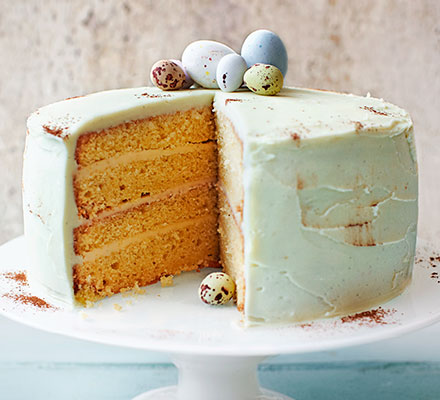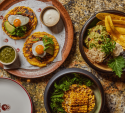Duck egg sponge cake
Duck eggs make this sponge extra light and fluffy – cover in a rich buttercream for a showstopping Easter bake or stunning birthday cake
-
Prep:1 hrs
Cook:35 mins
- More effort
Nutrition per serving
-
kcal 717
-
fat 38g
-
saturates 22g
-
carbs 86g
-
sugars 71g
-
fibre 1g
-
protein 7g
-
salt 0.7g
Ingredients
- 250g butter, melted, plus extra for greasing
- 5 duck eggs, or 250g weight of beaten hen's eggs
- 250g white caster sugar
- 1 tsp vanilla extract
- 250g self-raising flour
- 1 tsp baking powder
- 250g unsalted butter, chopped, at room temperature
- 600g icing sugar
- 2 tbsp milk
- 1 vanilla pod
- food colouring (optional)
- cocoa powder, for dusting
- selection of mini chocolate eggs
Tip
EggsDuck eggs are becoming more readily available, either through farm shops or bigger supermarkets. They make the best sponges (both for flavour and texture), but if you can’t get hold of any, substitute 250g weight of beaten hen’s eggs.
Eggs are best stored in the fridge, but if you’re making a sponge you’ll need to get them to room temperature before using. A quick way to do this is to submerge the eggs in warm water for a few moments - this will help to stop your cake batter splitting when the eggs are added to the creamed butter and sugar.
Method
Heat oven to 180C/160C fan/gas 4. Grease then line 2 x 20cm cake tins with baking parchment and grease the parchment too.
Crack the duck eggs into a large mixing bowl. Add the sugar and whisk for about 5 mins until pale and fluffy. Keep whisking as you add the melted butter, a little at a time, followed by the vanilla extract.
Fold in the flour and baking powder with a large metal spoon until you can’t see any pockets of flour. Divide the mixture between the two prepared tins and bake for 35 mins or until bouncy to the touch and a skewer poked into the middle of the cake comes out clean. Leave the cakes to cool in the tin, then turn out onto wire racks when cool enough to handle.
To make the buttercream, tip the butter into a big bowl and whisk with an electric hand whisk. Add the icing sugar, 2-3 tbsp at a time, until it’s all incorporated, adding the milk halfway through the process. Scrape the seeds out of a vanilla pod, add them in and whisk again. Transfer half the buttercream to another bowl and, if using, stir your food colouring into one of the mixtures. I used blue and a dash of green to create a classic duck egg shade.
When the buttercream mixtures are ready and the cake is cold, level the cakes with a bread knife, cut each one in half through the middle and stick all the layers together with the uncoloured buttercream. Cover the whole cake with a thin layer of the coloured buttercream – this will seal in any crumbs. Chill the cake for 30 mins, then cover with the rest of the buttercream and use a palette knife or pastry scraper to make the buttercream flat.
To finish, sprinkle about 1/4 tsp of cocoa powder onto the cake to create a speckled design. Repeat this in different sections of the cake, then top with a cluster of mini chocolate eggs and serve. Will keep for 2-3 days.





















